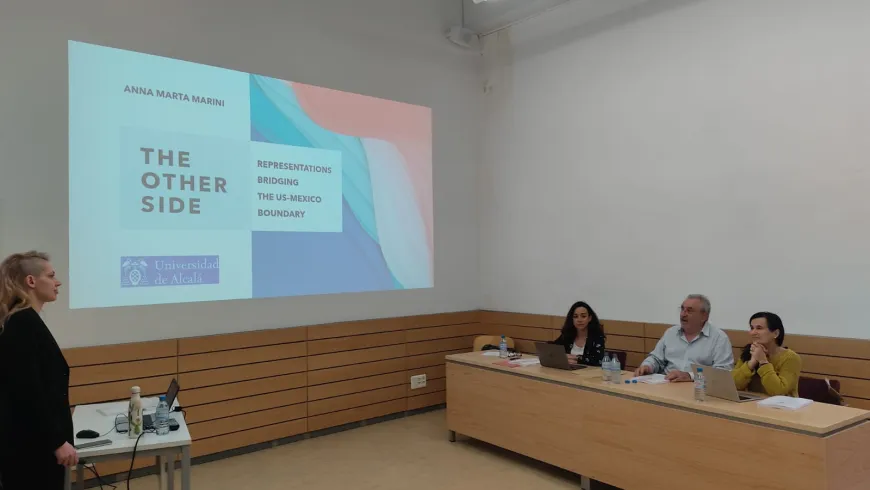New PhD dissertation defended at the Instituto Franklin-UAH on the representation of the border between Mexico and the United States
On Thursday, March 21st, 2024, Anna Marta Marini defended her PhD dissertation entitled “The Other Side. Representations Bridging the US-Mexico Boundary,” directed by Dr. Julio Cañero Serrano, Associate Professor at the Universidad de Alcalá, and co-directed by Dr. Ignacio González Díaz de la Serna, Associate Professor at the Universidad Nacional Autónoma de Mexico and the North American Research Center. This research is part of the interdisciplinary Doctoral Program in North American Studies of the Instituto Franklin-UAH.
The examining board was presided by Dr. José Antonio Gurpegui Palacios, Professor at the Universidad de Alcalá, with Dr. Isabel Díaz Sánchez, Associate Professor at the Universidad de Alicante, as secretary and Dr. Silvia Betti, Associate Professor at the University of Bologna, as member. The qualification of the thesis has been outstanding by unanimous decision.
This paper, which spans American film production from the post-World War II years to the present, examines representations of Mexico in mainstream films produced in which American characters cross the border and experience Mexican places, with the aim of highlighting the recurring narrative structures that characterize them. By questioning the function of stereotypes as a reinforcement of hegemonic Whiteness, the crucial thesis underlying the analysis is that Mexico is never really represented but, rather, is an imagined heterotopia instrumental to the personal needs and journeys of U.S. subjects. In this imaginary space - to some extent similar to the so-called tourist bubble –dangerous but at the same time controlled, it is the ideal theater of transformative journeys, as it provides evidence that challenges the protagonists and facilitates the rediscovery of their “true” American Americanness. Taking into account the existing mine of studies on the ideological role of Mexico in the American imagination and national identity, and acknowledging the vast scholarly literature analyzing the representation of the Mexican-American border region in film, the thesis develops an original articulation of the archetypal model of the hero's journey, and applies it to the selected corpus of films to demonstrate its validity. In addition, the study devotes specific attention to the centrality of hegemonic masculinity in the narratives examined, as it is often the vehicle for American exceptionalism and notions of ethnoracial superiority, as well as the fulcrum around which gender roles and American femininity are structured. The chapter devoted to the development of the model thus precedes three chapters in which the films are analyzed in detail, structured according to three main categories that define the imagined Mexico. These categories are based on the reasons why the American characters cross the border to the south and, consequently, the types of dangers encountered. Thus, Mexico is depicted as a lawless land where American criminals can find sanctuary, a non-place for American entertainment, or a country captive to its own nature and cultural heritage, where only American explorers and scientists can prevail. Throughout the chapters, the racialized perception of Mexico in American cinema and its ideological function emerge, showing how the heterotopia of the imagined Mexico is informed by and, at the same time, instrumental to the reinforcement of popular culture and discourses on the subject.
Anna Marta Marini has completed undergraduate and graduate studies in Linguistic and Cultural Mediation at the Università degli Studi di Milano, (specialization in Anglo- and Spanish-American cultures, as well as in Mexican studies), advanced postgraduate studies in Public History at the Università de Modena e Reggio Emilia. Her FPI project and thesis (co-directed with CISAN-UNAM) focuses on the mutual representation of cross-border otherness in Mexican and American cinema. Her main areas of research are the discursive and cultural representation of US borderlands and Mexican-American communities; the critical analysis of discourse related to structural/cultural/direct violence; and the re/construction and narration of otherness through cinema and comics in the horror, gothic and (weird)Western genres.


